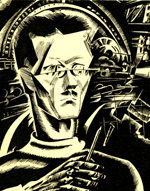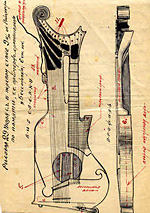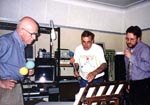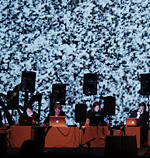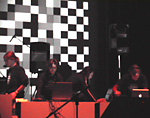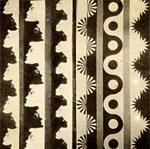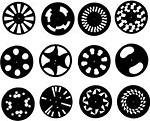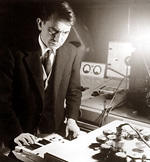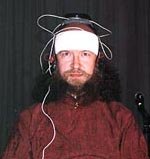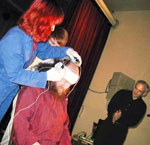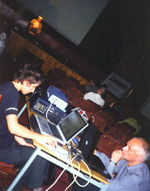contact
MOMus
Museum of Modern Art
Costakis Collection
21 st Kolokotroni Str.
Moni Lazariston
56430, Stavroupoli
Greece
| Favorite projects since 1992 | |
| Generation Z exhibition | |
We are very sorry: since 24 February 2022 the letter Z became a simbol of Russian fascism and national disgrace...Generation Z exhibition is a part of an ongoing project by Andrei Smirnov and Liubov Pchelkina that is attempting to reconstruct the censored history and culture of the Russian artistic Utopia of the 1910-1920s – a kind of 'network culture' of revolutionaries in art who realized seemingly unrealizable projects in sound, invented new musical machines, and who explored concepts and methods that offered a promising basis for future scientific and cultural development. It is a story that is still relatively unknown in the West and is only now beginning to come to light in Russia itself. In Stalinist Russia, when someone influential was shot or sent to the Gulag, their physical disappearance was not enough - they were also retroactively transformed into traitors and saboteur, eliminated from the public record and wiped from group photographs as though they had never lived. This was true also for the whole emerging culture of 1920s. The exhibition offers an introduction to some of the key figures of the period and their areas of research. [more info] 9.06-20.07.2011. GENERATION Z at OSA ARCHIVUM, Budapest, Hungary
|
|
| Sound in Z (2008) | |
We are very sorry: since 24 February 2022 the letter Z became a simbol of Russian fascism and national disgrace...Sound in Z is an exhibition of audio, visual, textual and documentation material that offers an introduction to experiments in sound and electronic music in early 20-th century Russia as a part of Generation Z project. The exhibition is curated by Andrey Smirnov and Matt Price with assistance from Christina Steinbrecher in the frame of the project FROM ONE REVOLUTION TO ANOTHER - Carte blanche to Jeremy Deller at Palais de Tokyo, Paris, (20.09.08 - 22.01.09). The exhibition revolves around the archives of the Theremin Centre, Moscow. It offers an introduction to some of the key figures of the period and their areas of research. Most of the featured documentation, sound and footage has not previously been made available and almost unknown. Being studied and analysed, these forgotten facts can change the view at the history of music technology. [more info] |
|
| Theremin Center for Electroacoustic Music, 1992 | |
The Theremin Center was founded by A.Smirnov in Moscow in 1992 as a working environment for young musicians, composers, visual artists, programmers and engineers interested in applications of new technology in Sonic and Visual Arts, having uncommon creative ideas, integrating different professional skills in multimedia projects and cross-disciplinary research. It was an attempt to establish a link between traditionally conservative world of academical musical education and new emerging culture of the experimental art and music. From the start the Theremin Center was intended to operate on a non-profit basis and most services and equipment were donated by it's founders and sponsors. Professor Jon Appleton founded the International Advisory Board and helped in developing the Theremin Center and establishing continuous relationships within the international musical and scientific communities. The Moscow State Conservatory has provided space. It was hosted by the Laboratory for Sound Recording and Musical Acoustics whose history is inextricably interwoven with the development of music and audio technology in Russia during the 20-th Century. It was the place where in 1960s Leon Theremin was conducting his research. Since 2005 the Theremin Center became a part of the Center for Electroacoustic Music at Moscow State Conservatory being integrated in the official educational programs as well as independent cultural projects. [more info] |
|
| Laptop Cyber Orchestra (2006) | |
Moscow Laptop Cyber Orchestra <CybOrk> was founded by A. Smirnov in 2006 at the Theremin Center for Electroacoustic Music at Moscow State Conservatory. It is an ‘open source', improvised and highly integrated sonic environment, created by musicians, artists and programmers. It is a large net of spatially separated mobile workstations, having local sound and integrated into wifi network. It explores all sorts of interaction between players, algorithms, sensors, environments and audiences. Although CybOrk programs contain pre-composed and structured music, the core esthetics is based on Cyber-Jam idea – free improvised session, based on exploration of some predetermined common algorithms, when no other formal sonic, ompositional or genre boundaries are fixed, no rules of acting are applied. There is only an entry point that triggers adventurous search for constantly changing identity evolving in common time and place, resulting in a self-generative and self-organizing sounding and visual textures raveling and unraveling, fraying and renewing back producing a rich palette of clippings, raw digits, dense overdriven noises, deep drones or skipping solos. [more info] |
|
| Sound out of Paper (2005) | |
Sound out of Paper is a research project in progress related to the technology of synthesizing sound from light called Graphical (Drawn) Sound technique which was invented in Russia in 1929 as a consequence of the newly developed sound-on-film technology. This invention came at least twenty years too early while the World War II was already at the threshold. As a result by late 1930-s the work in this domain effectively came to a halt. Although there were several short articles published in USA by V.Solev (1935), most publications about research and developments in the USSR were in Russian. At the same time the most important documents were never published at all and were circulating in manuscript form, similar to “Samizdat” (self-published forbidden literature). Because of the cross-disciplinary nature of the new technique, people involved in it had to be skilled in acoustics, mathematics, sound-on-film technology and engineering. Having no developed terminology, many mistakes and unexpected “puzzles” appeared in their writings. Fortunately many unique archives survived and are collected now at the Theremin Center in Moscow. Over two hours of synthesized music produced in 1930s twenty years before the foundation of electronic music were discovered recently at the Russian State Film Archive. [more info] |
|
| The Open-Library of Russian resources on history and aesthetics of Electroacoustic Music and Multimedia | |
The Open-Library was published by A.Smirnov at the Theremin Center web-site in 1997. It was an attempt to fill the lack of information related to the history and aesthetics of electronic and electroacoustic music, multimedia and music technology which were badly censored in 1950-80-s when the surrogate, known under the name "The Soviet Culture" was under construction, when any facts and trends which didn't correspond with the official view on art and culture were written out of histories, wiped out from the text books as though they had never existed.
The fear and interdictions of 1930-1970-s have led to ignorance of 1980-2000-s. Ironically this tradition kept strength even after "Perestroika". |
|
| Brain JAZZ (1985/2001) | |
|
Brain JAZZ is an interactive performance/installation for one soloist, one programmer, two assistants and MAX/MSP based interactive brain-wave biofeedback system. |
| Cross-Media Project (X-Media), 1995-1997 | |
|
The Cross-Media project was an attempt to create a working environment uniting young musicians, composers, multidisciplinary artists, animators, programmers, constructors, who showed interest toward the use of the latest electronic technologies in art. By assumption it would result in a creative symbiosis, or, more likely, in the unity and struggle of the opposites to provoke an exchange of ideas, concepts, experiences, cooperation and co-creation it the realm of multimedia in the broad sense of the word, virtual reality, cyberspace, interactivity... The goal was to create a crossroad, where representatives of most diverse trends in the arts, schools, aesthetics, studios etc. would inevitably meet. |
